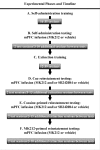Stimulation of medial prefrontal cortex serotonin 2C (5-HT(2C)) receptors attenuates cocaine-seeking behavior
- PMID: 20520599
- PMCID: PMC3055305
- DOI: 10.1038/npp.2010.72
Stimulation of medial prefrontal cortex serotonin 2C (5-HT(2C)) receptors attenuates cocaine-seeking behavior
Abstract
Serotonin 2C receptor (5-HT(2C)R) agonists administered systemically attenuate both cocaine-primed and cue-elicited reinstatement of extinguished cocaine-seeking behavior. To further elucidate the function of these receptors in addiction-like processes, this study examined the effects of microinfusing the 5-HT(2C)R agonist MK212 (0, 10, 30, 100 ng/side/0.2 microl) into the medial prefrontal cortex (mPFC) on cocaine self-administration and reinstatement of extinguished cocaine-seeking behavior. Male Sprague-Dawley rats were trained to self-administer cocaine (0.75 mg/kg, i.v.) paired with light and tone cues. Once responding stabilized, rats received MK212 microinfusions before tests for maintenance of cocaine self-administration. Next, extinction training to reduce cocaine-seeking behavior, defined as responses performed without cocaine reinforcement available, occurred until low extinction baselines were achieved. Rats then received MK212 microinfusions before tests for reinstatement of extinguished cocaine-seeking behavior elicited by cocaine-priming injections (10 mg/kg, i.p.) or response-contingent presentations of the cocaine-associated cues; operant responses during cocaine-primed reinstatement tests produced no consequences. MK212 microinfusions into the prelimbic and infralimbic, but not anterior cingulate, regions of the mPFC dose-dependently attenuated both cocaine-primed and cue-elicited reinstatement of extinguished cocaine-seeking behavior, but did not reliably affect cocaine self-administration. A subsequent experiment showed that the effects of MK212 (100 ng/side/0.2 microl) on reinstatement of extinguished cocaine-seeking behavior were blocked by co-administration of the 5-HT(2C)R antagonist SB242084 (200 ng/side/0.2 microl). MK212 administered alone into the mPFC as a drug prime produced no discernable effects on cocaine-seeking behavior. These findings suggest that stimulation of 5-HT(2C)Rs in the mPFC attenuates the incentive motivational effects produced by sampling cocaine or exposure to drug-paired cues.
Figures








Comment in
-
The serotonin 5-HT2C receptor in medial prefrontal cortex exerts rheostatic control over the motivational salience of cocaine-associated cues: new observations from preclinical animal research.Neuropsychopharmacology. 2010 Nov;35(12):2319-21. doi: 10.1038/npp.2010.119. Neuropsychopharmacology. 2010. PMID: 20948510 Free PMC article. No abstract available.
Similar articles
-
Blockade of 5-HT2A receptors in the medial prefrontal cortex attenuates reinstatement of cue-elicited cocaine-seeking behavior in rats.Psychopharmacology (Berl). 2011 Feb;213(2-3):307-20. doi: 10.1007/s00213-010-2071-9. Epub 2010 Nov 16. Psychopharmacology (Berl). 2011. PMID: 21079923 Free PMC article.
-
Effects of the 5-HT2C receptor agonist CP809101 in the amygdala on reinstatement of cocaine-seeking behavior and anxiety-like behavior.Int J Neuropsychopharmacol. 2014 Nov;17(11):1751-62. doi: 10.1017/S1461145714000856. Epub 2014 Jul 1. Int J Neuropsychopharmacol. 2014. PMID: 24984080
-
Stimulation of 5-HT(1B) receptors enhances cocaine reinforcement yet reduces cocaine-seeking behavior.Addict Biol. 2009 Sep;14(4):419-30. doi: 10.1111/j.1369-1600.2009.00162.x. Epub 2009 Jul 24. Addict Biol. 2009. PMID: 19650818 Free PMC article.
-
Dorsal medial prefrontal cortex (MPFC) circuitry in rodent models of cocaine use: implications for drug addiction therapies.Addict Biol. 2015 Mar;20(2):215-26. doi: 10.1111/adb.12132. Epub 2014 Mar 13. Addict Biol. 2015. PMID: 24620898 Free PMC article. Review.
-
The use of the reinstatement model to study relapse to palatable food seeking during dieting.Neuropharmacology. 2014 Jan;76 Pt B(0 0):395-406. doi: 10.1016/j.neuropharm.2013.04.030. Epub 2013 May 6. Neuropharmacology. 2014. PMID: 23660229 Free PMC article. Review.
Cited by
-
Serotonin2C receptors and drug addiction: focus on cocaine.Exp Brain Res. 2013 Oct;230(4):537-45. doi: 10.1007/s00221-013-3593-2. Epub 2013 Jun 8. Exp Brain Res. 2013. PMID: 23748692 Review.
-
Lateral Habenula 5-HT2C Receptor Function Is Altered by Acute and Chronic Nicotine Exposures.Int J Mol Sci. 2021 Apr 30;22(9):4775. doi: 10.3390/ijms22094775. Int J Mol Sci. 2021. PMID: 33946328 Free PMC article.
-
The reinstatement model of drug relapse: recent neurobiological findings, emerging research topics, and translational research.Psychopharmacology (Berl). 2013 Oct;229(3):453-76. doi: 10.1007/s00213-013-3120-y. Epub 2013 May 18. Psychopharmacology (Berl). 2013. PMID: 23685858 Free PMC article. Review.
-
Orexin/hypocretin role in reward: implications for opioid and other addictions.Br J Pharmacol. 2015 Jan;172(2):334-48. doi: 10.1111/bph.12639. Epub 2014 Jul 1. Br J Pharmacol. 2015. PMID: 24641197 Free PMC article. Review.
-
Serotonin 5-HT2C receptor protein expression is enriched in synaptosomal and post-synaptic compartments of rat cortex.J Neurochem. 2010 Jun;113(6):1504-15. doi: 10.1111/j.1471-4159.2010.06694.x. Epub 2010 Mar 24. J Neurochem. 2010. PMID: 20345755 Free PMC article.
References
-
- Acosta JI, Thiel KJ, Sanabria F, Browning JR, Neisewander JL. Effect of schedule of reinforcement on cue-elicited reinstatement of cocaine-seeking behavior. Behav Pharmacol. 2008;19:129–136. - PubMed
-
- Aronson SC, Black JE, McDougle CJ, Scanley BE, Jatlow P, Kosten TR, et al. Serotonergic mechanisms of cocaine effects in humans. Psychopharmacology (Berl) 1995;119:179–185. - PubMed
-
- Baker DA, Tran-Nguyen TL, Fuchs RA, Neisewander JL. Influence of individual differences and chronic fluoxetine treatment on cocaine-seeking behavior in rats. Psychopharmacology (Berl) 2001;155:18–26. - PubMed
-
- Barnes NM, Sharp T. A review of central 5-HT receptors and their function. Neuropharmacology. 1999;38:1083–1152. - PubMed
Publication types
MeSH terms
Substances
Grants and funding
LinkOut - more resources
Full Text Sources
Medical

